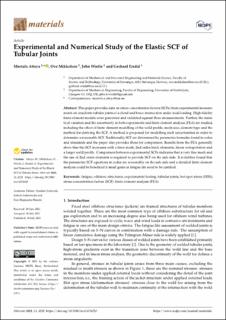| dc.contributor.author | Atteya, Mostafa | |
| dc.contributor.author | Mikkelsen, Ove | |
| dc.contributor.author | Wintle, John | |
| dc.contributor.author | Ersdal, Gerhard | |
| dc.date.accessioned | 2021-11-08T14:12:36Z | |
| dc.date.available | 2021-11-08T14:12:36Z | |
| dc.date.created | 2021-08-17T16:32:49Z | |
| dc.date.issued | 2021-07 | |
| dc.identifier.citation | Atteya, M., Mikkelsen, O., Wintle, J., Ersdal, G. (2021) Materials. 2021, 14 (15), . | en_US |
| dc.identifier.issn | 1996-1944 | |
| dc.identifier.uri | https://hdl.handle.net/11250/2828427 | |
| dc.description.abstract | This paper provides data on stress concentration factors (SCFs) from experimental measurements on cruciform tubular joints of a chord and brace intersection under axial loading. High-fidelity finite element models were generated and validated against these measurements. Further, the statistical variation and the uncertainty in both experiments and finite element analysis (FEA) are studied, including the effect of finite element modelling of the weld profile, mesh size, element type and the method for deriving the SCF. A method is proposed for modelling such uncertainties in order to determine a reasonable SCF. Traditionally, SCF are determined by parametric formulae found in codes and standards and the paper also provides these for comparison. Results from the FEA generally show that the SCF increases with a finer mesh, 2nd order brick elements, linear extrapolation and a larger weld profile. Comparison between experimental SCFs indicates that a very fine mesh and the use of 2nd order elements is required to provide SCF on the safe side. It is further found that the parametric SCF equations in codes are reasonably on the safe side and a detailed finite element analysis could be beneficial if small gains in fatigue life need to be justified. | en_US |
| dc.language.iso | eng | en_US |
| dc.publisher | MDPI | en_US |
| dc.rights | Navngivelse 4.0 Internasjonal | * |
| dc.rights.uri | http://creativecommons.org/licenses/by/4.0/deed.no | * |
| dc.subject | fatigue | en_US |
| dc.subject | offshore strukturer | en_US |
| dc.subject | finite element analysis | en_US |
| dc.title | Experimental and numerical study of the elastic SCF of tubular joints | en_US |
| dc.type | Peer reviewed | en_US |
| dc.type | Journal article | en_US |
| dc.description.version | publishedVersion | en_US |
| dc.rights.holder | © 2021 by the authors | en_US |
| dc.subject.nsi | VDP::Teknologi: 500::Materialteknologi: 520 | en_US |
| dc.source.volume | 14 | en_US |
| dc.source.journal | Materials | en_US |
| dc.source.issue | 15 | en_US |
| dc.identifier.doi | 10.3390/ma14154220 | |
| dc.identifier.cristin | 1926721 | |
| dc.source.articlenumber | 4220 | en_US |
| cristin.ispublished | true | |
| cristin.fulltext | original | |
| cristin.qualitycode | 1 | |

